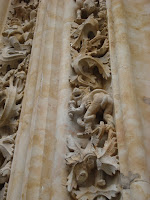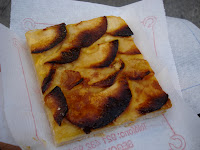Tomorrow will be the last day of my second week of classes here in Segovia. It's incredible how fast time passes once you have something to keep you occupied! I am taking four classes here, all in Spanish, and all taught by professors from Spain, which is marvelous. I learn probably a gajillion new words every day; so many in fact, that all the margins of my notes are completely covered with new vocabulary.
I start off my day with the History of Spanish Art and Architecture. The class is early in the morning, super early by Spanish standards. When I get up to get ready, my host family is all asleep and I have to tip toe through the darkness, feeling my way to the bathroom, all the while trying not to crash into anything and make a ruckus. I feel so bad for my host mom! I think she feels obligated to get up in the morning and see me off, because she always fixes me my breakfast, but I know that she would much rather be sleeping.
 |
| La Catedral |
|
Anyways, about the actual class. So far, we've been learning all the terms associated with architecture, sculpture, and painting, some of which I never knew in English, let alone Spanish. I am super excited to get started in the history portion of the class because Segovia is so rich in architecture, with Roman, Medieval, and Gothic edifices throughout the city.
My next class is Grammar. I'm finding out just how different grammar and vocabulary in Spain is from what I learned in high school and at UAA. Goodness! I feel like I have to relearn half the things I thought I knew.
My last class of the morning is about the European Union and Spain. I didn't know much about the EU before starting the class, and it has been super interesting so far. The professor (who is also the director of the program) is absolutely fabulous. She has so much energy, it's amazing. She likes to take us on mini-excursions through Segovia to show us cool things, some that have to do with the class, and some (like where to get the best hot chocolate and sangrias) that don't.
After this morning class, which ends about 1:10, I return to my house. The family eats la comida, or lunch, at about 2:00 and it is the biggest meal of the day. Usually there are three courses; the first is a vegetable or some kind of starch; the second is a meat dish; and the third is a dessert of fruit (though on the weekend we can have the treat of ice cream!). This being the most important meal of the day, the whole family eats together. It is crazy difficult to keep up with what is being discussed; everyone speaks so quickly that I barely understand what is going on. I don't know how many times someone made a joke and everyone else laughed, while I remained blank faced, and my host mom had to explain to me why it was funny.
After lunch there is a rest time before my last class at 5. I have actually started taking a siesta because after eating such a large meal, I feel like I could sleep standing up. It's super interesting walking through the streets at this time, between 3 and 6; all the shops are closed and hardly anyone is out, because everyone is eating lunch and taking their siesta. I love that naps are part of the daily schedule! I know I have lamented the lack of naps in the U.S.
My last class of the day is Literature. We started with reading a few poems by Espronceda from the Romantic period. The professor is absolutely fantastic; he takes us step by step through the poems and helps us analyze them. He's also absolutely hilarious, and is always joking around with us.
These last few days we have actually been going to presentations instead of having a regular class. In Segovia from September 18 - 16, the Hay Festival takes place, which is a collection of presentations by and about prominent writers from around the world. The presentations we went to have been about the legends and myths of Segovia and the region of Castilla y León. It was super fascinating to hear all the stories told in the area and to think about the stories I've heard back home.
One such story was that of the Bú, which is a gigantic owl, with eyes like soup bowls, and claws as big as animal cages. Parents in Spain use the Bú to scare their children into cleaning their rooms, eating their food, going to bed, and the like. One story we heard was that parents would go so far as to open the window and call out into the night saying "Bú, come get my child and take him away because he is being bad!" It sounds absolutely terrifying! Imagine, a huge owl coming and plucking you up out of your room and taking you who knows where because you didn't listen to your parents.
That is pretty much my average day! I am looking forward to learning all kinds of wonderful things this semester (and sharing them with you!).
'Ta Luego!









































